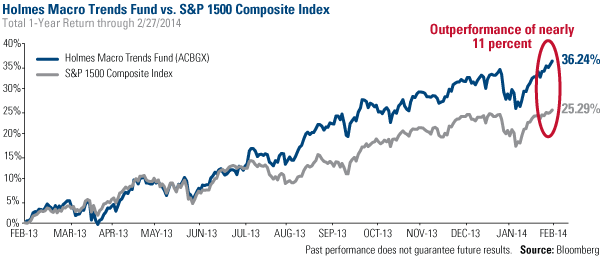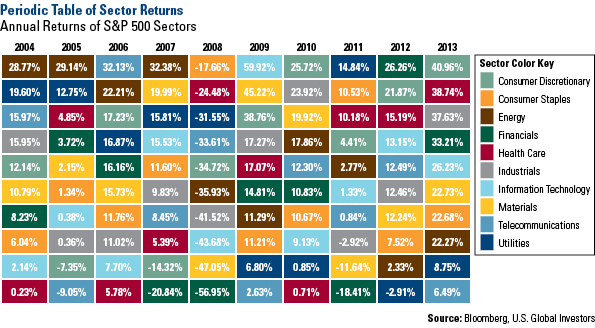
What Areas of the Market Will Remain in the Limelight?
The current bull market has been five years in the making. Since the bottom on March 9, 2009, the S&P 500 Index has grown an incredible 174 percent. With this spectacular performance, investors are asking if U.S. companies will stay in the limelight or if it is time to draw the curtain on equities.
While I was in Los Angeles at a leadership event for CEOs from around the world, I asked John Derrick, CFA, director of research, to shed some light on the subject.
We believe investors should remain in equities, but selectively find high-quality growth companies trading at reasonable prices and located in the strongest areas of the market. One of the funds he co-manages, the Holmes Macro Trends Fund, has had significant success over the past year employing this strategy.
You can see in the chart below that, as of February 27, the fund has outperformed the S&P 1500 Composite Index by almost 11 percent in one year. See the fund’s performance history.
Here are the questions I posed to John along with his responses.
Q. Can you discuss the macroeconomic factors that contributed to the fund’s outperformance and do you think it will continue?
Comparing the fund to the benchmark index by sector, we had particular stock-picking success in the consumer discretionary, health care and industrials sectors.
This isn’t surprising due to the synchronized global recovery out of the U.S., China and Europe that we’ve talked about many times before. Companies’ economic confidence has increased and as spirits lift, many businesses are sitting on piles of cash. As a result, they’ve been boosting their capital budgets to invest in their businesses.
Over the past year, this environment has been very positive for cyclical stocks that typically sell goods and services beyond basic needs.
We talked about the major effect that increased investment spending would have on cyclical companies. We wrote that capital investment helps propel the economy and boosts productivity and profits. Investors also tend to see a boost: As companies begin spending their cash on things such as productivity-increasing software and capital equipment, businesses in technology and industrials sectors likely benefit.
We’re especially pleased the Holmes Macro Trends Fund model identified these cyclical areas of the market, which helped the fund outperform.
Q. Please talk more about the fund’s model and how it identifies the strongest sectors.
We start with a top-down, macro view of the S&P 500 by analyzing the returns of each of the 10 sectors over different periods of time. The fund dynamically adapts to those sectors that show the best returns over all of these time periods. This helps us identify potentially long-term trends before they become widely accepted in the marketplace.
Oftentimes, the trends are a result of a change in demographics, market dynamics or government policy.
Q. Can you give an example of a long-term trend?
Take a look at the periodic table of sector returns, which helps illustrate historical long-term sector trends. For example, from 2004 through 2007, energy sector returns were consistently strong. Four years in a row, energy was either the best-performing sector or second-best. All years showed double-digit returns.
This multi-year run was significantly influenced by government policies. If you’ll remember, China’s economy was quickly maturing, with its massive urbanization trend and incredible infrastructure buildout. The country’s growth significantly changed its energy structure. Oil consumption increased significantly, and the country’s growth trickled down to other commodity-dependent countries such as Brazil, Russia and the Middle East.
Q. U.S. Global is known as a growth-at-a-reasonable price investor. Talk about how this GARP approach melds with the sector analysis.
Because sectors exhibiting current strength today can sustain that vigor over an extended period of time, we gain confidence in investing in stocks in those particular sectors. From there, we look for the faster growing companies with robust fundamentals. Specifically, we like businesses growing revenues at more than 10 percent, generating at least 20 percent earnings growth and providing a 20 percent return-on-equity.
However, before we purchase shares, we consider valuation, quality of management, debt levels, potential catalysts and other factors.
Join U.S. Global’s Webcast
Last week, John read some compelling research that supports the continuation of these cyclical areas of the market. Make sure you join U.S. Global’s webcast on March 5, as he’ll be talking about that data and much, much more with Brian Hicks and me.
Add the webcast to your calendar now.
Please consider carefully a fund’s investment objectives, risks, charges and expenses. For this and other important information, obtain a fund prospectus by visiting www.usfunds.com or by calling 1-800-US-FUNDS (1-800-873-8637). Read it carefully before investing. Distributed by U.S. Global Brokerage, Inc.
Past performance does not guarantee future results.
All opinions expressed and data provided are subject to change without notice. Some of these opinions may not be appropriate to every investor. The S&P 500 Stock Index is a widely recognized capitalization-weighted index of 500 common stock prices in U.S. companies. The S&P 1500 Composite is a broad-based capitalization-weighted index of 1500 U.S. companies and is comprised of the S&P 400, S&P 500, and the S&P 600.

































